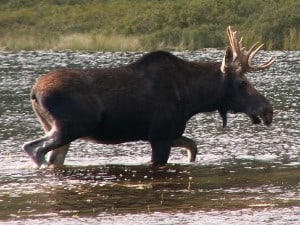
The shrinking population of moose in northern Minnesota has convinced the federal government to consider listing the iconic animals as “Endangered.” The U.S. Fish and Wildlife Service (USFWS) announced yesterday that it will evaluate the species for possible protection.
Moose populations in northern Minnesota have declined drastically over the past decade. The number of them today is estimated at about 4,000. In 2006, there were approximately 9,000 moose in the state. Some scientists have said the species could be entirely gone from Minnesota within 10 or 20 years.
The USFWS announcement comes about a year after the Center for Biological Diversity and Honor the Earth submitted a petition requesting the consideration. The petition points to global warming as a key cause of the decline.
“A. andersoni is threatened by a myriad of factors, including habitat loss and disease, but the greatest threat confronting the species is climate change, which is exacerbating existing problems and creating new adverse effects,” the petition reads.
Moose are very sensitive to changes in temperature. They need ponds and wetlands to stay cool in the summer, and if winters are too warm, ticks and other parasites can cause problems. The state’s large wolf population is also a factor – preying in particular on calves. But researchers believe the wolves are often eating animals that were already weakened by environmental conditions.
Pointing to scientific publications, the moose advocates say the animals’ sensitivity when combined with expected climate change ahead will seriously threaten their ability to survive in Minnesota.
- Less snow – Nearly 75 percent of winters in the past three decades have seen below average snowfall. By the end of the century, there will be 30 to 60 percent fewer snow days in the Great Lakes region each year.
- Food sources – Boreal vegetation that moose eat, including black spruce, paper birch, and northern white cedar, are also expected to decline as the ecological zone shifts north about 100 miles
- Warmer weather – Temperatures above 23 degrees Fahrenheit in the winter and above the mid-50s in the summer cause heat stress in moose. This can mean heart problems, reduced feeding, less breeding, and a host of other problems.
The Center for Biological Diversity and Honor the Earth say listing the species as “Endangered” could help in several ways: highlight the harm of continued greenhouse gas emissions; providing federal funding for research; and protect the habitat moose need to survive a warmer north woods.
After reviewing the petition, the USFWS declared it met the criteria for consideration, and that they would begin a lengthy process to gather more information.
“The petition to list the U.S. population of the northwestern subspecies of moose (Alces alces andersoni), found in Michigan, Minnesota, North Dakota and Wisconsin, provided substantial scientific or commercial information that listing under the ESA may be warranted,” the agency stated.
A lengthy public review period now begins, starting with a sixty-day comment period on the status of the moose. Comments are due August 2, 2016 and can be submitted at this link.

